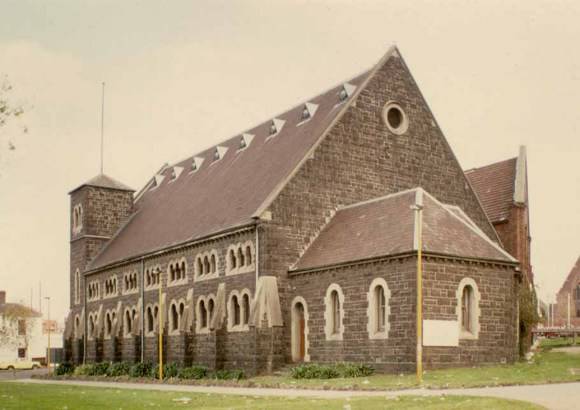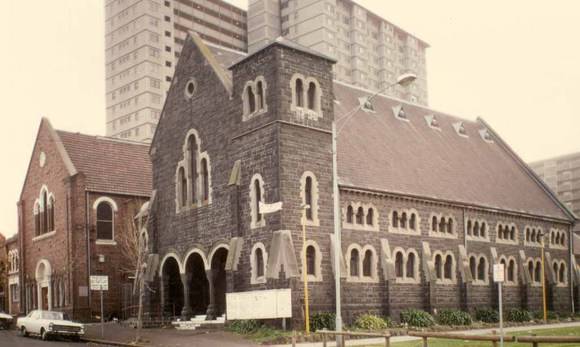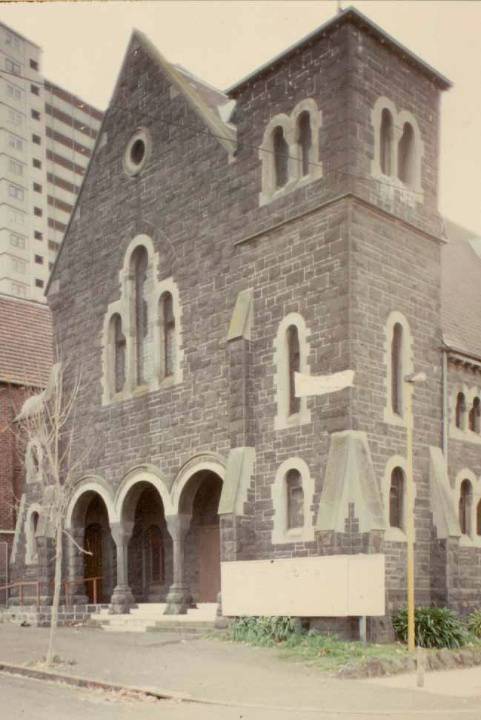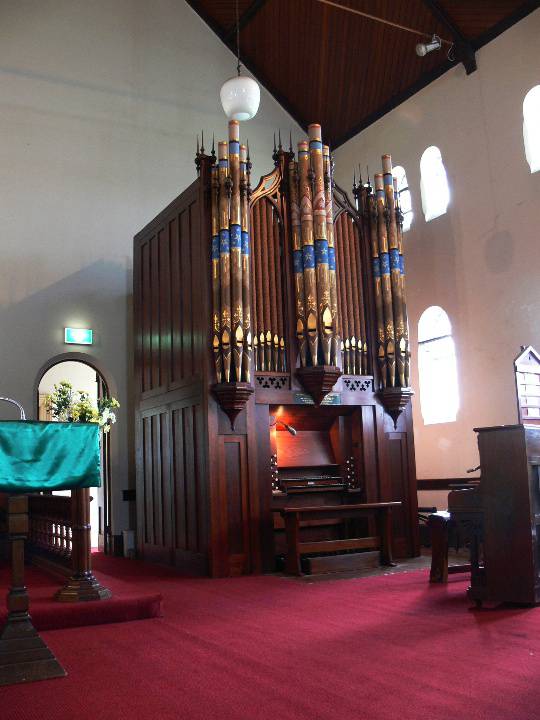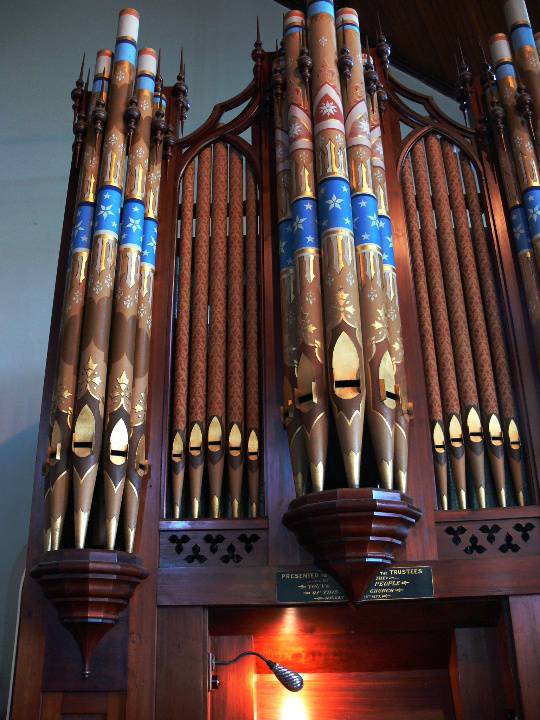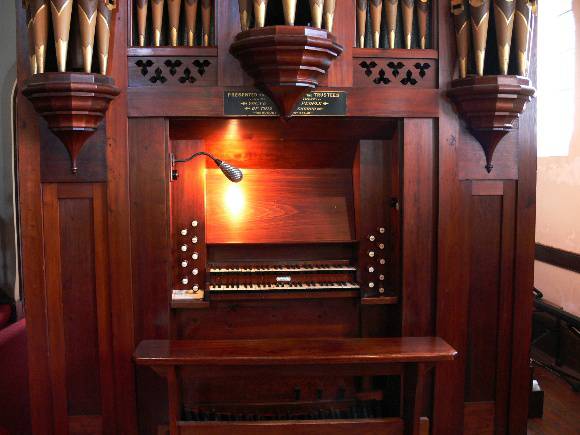| Back to search results » | Back to search page » |
|
Former Wesleyan Methodist Church & Organ
Other NamesCarlton Methodist Mission , Church Of All Nations Location180 Palmerston Street,, CARLTON VIC 3053 - Property No B4851
File NumberB4851LevelState |
|
Statement of Significance
What is significant? The Churchwas built in 1869-70 to a design by the distinguished Melbourne architect Joseph Reed of Reed & Barnes. It replaced a timber church which had opened in Palmerston Street in 1861. In 1869 Reed was commissioned to design a larger church of bluestone, which opened 6 March 1870. The contractor was John Pigdon. Due to the lack of funds the top of the tower, the spire and the side balconies inside were never built and the nave was shortened. In 1876 the prominent Melbourne organ builder George Fincham was commissioned to build an organ for the church, the funds for which were raised by the pupils at the school and the younger members of the congregation. Following the 1890s depression Carlton suffered unemployment and poverty and by the early twentieth century it was regarded as a slum area. In 1914 the church was designated a mission circuit and in 1918 its name was changed to the Carlton Methodist Mission. In 1933 during the Great Depression a new mission hall, designed by the architect A S Eggleston, was built adjacent to the church. In the post-war period Carlton became the place of first settlement for successive waves of newly-arrived immigrants, at first mainly Italians. In the 1950s and 1960s the Housing Commission of Victoria began large-scale slum reclamation projects in the area and constructed massive high-rise towers on the Carlton Estate adjacent to the church. The church was innovative in its approach to migrant services, such as the teaching of English, and in the 1960s, with the congregation including large numbers of Spanish, Portuguese, Macedonian and Arabic speakers, simultaneous translation of the services into these languages was provided by interpreters sitting in booths in the gallery. In 1966 the church was renamed the Church of All Nations, to better reflect the diverse origins of the congregation.
The Church lies on the southern edge of the Carlton Estate of high-rise residential towers. The Church is a bluestone building in the Norman Romanesque style with freestone dressings. The front elevation has a porch beneath three Romanesque arches and a tower to one side. Internally there is a gallery at the rear which retains the 1960s translation booths, now used as office space. At the front is an elaborate timber pulpit approached by steps on each side and in the north-east corner the Fincham organ. To the west of the church is the 1930s mission hall, an Inter-war Spanish Mission style building of clinker brick with rendered dressings. The Fincham pipe organ is a two manual position in the gallery to the front of the church. It retains its original mechanical actions, console, and attractive case and the ornate decoration on the spotted metal display pipes.
It retains all of its original brilliance, sparkle and clarity of sound.
How is it significant? The Church of has historical, architectural and social significance to the state of Victoria.
Why is it significant? The Churchhas historical significance for its association with immigration to Victoria in the post-World War II period and with the assimilation of migrants into Victorian society. In the 1950s and 1960s Carlton was a focus for recently arrived immigrants and in the 1960s particularly the church demonstrated innovation in worship and migrant services that was at the forefront of such services in Victoria.
The Churchhas historical significance for the pipe organ built by George Fincham in 1877. George Fincham founded the most significant organbuilding enterprise in the colonial period of Australia and this organ is one of the best examples now surviving from his best period. Its significance is enhanced by the presence of the original mechanical actions and consoles, an attractive case, well-suited to its surroundings, and ornate decorations on the display pipes.
The Church has historical and social significance as an important place of worship and of community assistance for local residents and newly arrive migrant since the nineteenth century.
The church has architectural significance as a fine example of the Norman Romanesque style in Victoria, and of the work of the architect Joseph Reed, Melbourne's most prominent architect at this time, who designed almost every major church in Carlton.
Classified : 05/03/1987
Revised: 12/11/2008
Organ Statement of Significance: A two-manual organ of 14 stops built by George Fincham, the case, great and pedal organs dating from 1877 and the swell organ from 1886. The instrument remains unaltered from the original, apart from the introduction of tuning slides and electric blowing. It retains its original tonal scheme, pipework, action, three-tower case and intricately diapered facade pipes. This is one of the finest surviving works of its builder and of special tonal excellence.
Classified:20/04/1989
Revised: 12/11/2008
Group
Religion
Category
Church


